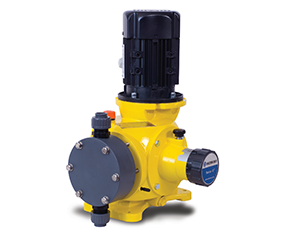The metering pump manufactured by the metering pump manufacturer plays an important role in industrial production as a precision conveying equipment. Its high precision, stability, and reliability make it one of the indispensable devices in many industries. With the continuous advancement of technology and the expansion of application fields, the performance of metering pumps will continue to improve, providing better support and guarantee for the production of various industries.
With the continuous advancement of technology, metering pumps are also constantly innovating and improving in design and manufacturing. Modern metering pumps have higher precision, more stable performance, and longer service life, providing better support and guarantee for industrial production. At the same time, with the application of intelligent technology, metering pumps have also begun to develop towards intelligence and automation, which can achieve remote monitoring, fault diagnosis, parameter adjustment and other functions, further improving production efficiency and safety.
What are the performance differences between different types of metering pumps?
Plunger metering pump
Pressure: Able to withstand high pressure, the flow rate remains almost unchanged when the outlet pressure changes, up to a maximum pressure of 350MPa. It is commonly used in chemical and water treatment processes under high pressure and high temperature conditions.
Accuracy: The measurement accuracy is high, generally up to ± 1%, and the flow rate can be dynamically adjusted from 0% to 100%. The liquid delivery flow rate can be accurately controlled by adjusting the plunger stroke length or reciprocating frequency.
Medium adaptability: It can transport liquids with high viscosity and even large particle impurities, but due to the contact between the plunger and seal and the medium, it is not suitable for transporting corrosive slurries and hazardous chemicals. The appropriate plunger material and sealing form should be selected according to the properties of the transported liquid.
Flow range: The flow range is relatively wide, usually 4-15000 liters per hour.
Pulse: The single plunger pump has a larger pulse, while the dual plunger design can reduce the pulse and make the operation smoother.
Diaphragm metering pump
Sealing performance: With good sealing performance, the conveyed medium is separated from the driving lubrication mechanism by a diaphragm, achieving no leakage. It is suitable for conveying corrosive liquids, volatile or toxic liquids, etc., and can effectively prevent liquid leakage and pollution.
Pressure: The maximum discharge pressure of a mechanical diaphragm metering pump generally does not exceed 1.2 MPa; The outlet pressure of hydraulic diaphragm metering pump can reach 100MPa, suitable for occasions with different pressure requirements.
Accuracy: The hydraulic diaphragm metering pump has a measurement accuracy of ± 1% within a 10:1 adjustment ratio range; The measuring accuracy of the mechanical diaphragm metering pump is ± 2%.
Medium adaptability: It can transport high viscosity media, abrasive slurries, and hazardous chemicals, but the tolerance of different materials of membranes to media varies.
Flow regulation: Adjust the flow by rotating the adjustment handwheel to change the diaphragm extension distance or adjusting the motor frequency, which is more convenient to adjust.
Electromagnetic metering pump
Pressure: Suitable for medium and low pressure conditions, with low power.
Accuracy: High flow accuracy, capable of accurately controlling liquid delivery volume.
Volume and operation: Small in size, light in weight, easy to operate, easy to install and maintain, suitable for use in places with limited space
Control performance: Using electronic control circuits to generate electromagnetic pulse drives, it can achieve automated control and can be linked with other devices. Equipped with corresponding controllers, it can achieve remote control, flow monitoring, and fault alarm functions.
Flow range: The flow rate is relatively small and is mostly used in small-scale dosing systems for water treatment, laboratories, and small-scale chemical equipment for micro dosing systems.
Peristaltic metering pump
Sealing: The liquid is completely isolated from the pump body, and the liquid is transported through a squeezed hose without contamination or leakage risk, effectively avoiding corrosion and contamination caused by contact between the liquid and the pump body.
Accuracy: It can provide high-precision flow control, usually with an error of less than 1%, ensuring accurate measurement and proportioning.
Medium adaptability: It can transport liquids of various properties, including corrosive liquids, liquids containing solid particles, high viscosity liquids, etc., and has strong adaptability to the medium.
Maintainability: The structure is simple, the failure rate is low, the maintenance cost is low, and there is no need for complex sealing maintenance and lubrication systems. The pump head replacement is quick, safe, tool free, and the operator can master the replacement skills without special training.
Pressure and flow rate: The working pressure is generally low, and the maximum working pressure is usually within 7 bar. The flow rate range is relatively narrow, usually 0.1-2000ml/min
A plunger pump is a common metering pump, which works by reciprocating the plunger in the cylinder to suck and discharge liquid. Piston pumps have the advantages of high conveying flow rate, stable pressure, and high precision, making them suitable for applications with high fluid requirements. Gear pumps use the meshing between gears to transport liquids to the desired location. They have a simple structure, reliable operation, and are suitable for transporting viscous liquids. Screw pumps utilize the spiral cavity between the screw and the outer wall to compress and discharge fluids, making them suitable for conveying high viscosity media.
The working principle of a metering pump is to use changes in the internal space of the pump body to achieve the suction and discharge of liquids or gases. In each working cycle, a series of periodic movements occur inside the pump body, such as compression, expansion, etc., to achieve accurate measurement and delivery of fluids. Metering pumps can be divided into different types based on their working principles and structural designs, such as plunger pumps, screw pumps, gear pumps, etc. Each type of pump has its unique advantages and applicable range.
